Nirav Raval, MD, Medical Director of Thoracic Transplant, Advent Health Transplant Institute, describes heart disease; signs and symptoms to look for, and what Barostim technology can do to benefit patients suffering from heart disease where other options have failed them.
Interview conducted by Ivanhoe Broadcast News in November 2019.
I want to start by asking you a little bit about heart failure. Can you explain for our viewers what heart failure is?
Dr. Raval: A lot of things can actually contribute to heart failure, but essentially heart failure means that the heart’s not pumping enough blood to supply the needs of the body.
And what can cause that?
Dr. Raval: Many things can cause heart failure. A heart attack might damage heart muscle and allow for a weakened condition of the heart, and therefore the heart’s not able to supply the blood that the body really needs. Other things can be genetic, for example, toxins that might affect the heart. Even things like pregnancy sometimes can cause heart failure as well.
When a person has heart failure, is this something that happens over a long period of time? Are there subtle symptoms, can you explain what people might be feeling?
Dr. Raval: Everyone’s heart failure journey is a little bit different. Some people can have very acute heart failure that happens all of a sudden. They may not have had any symptoms at all, and something happens to them, like a heart attack for example. Some folks may have a course that’s slower. For example, a genetic predisposition to heart failure may cause weakening of the heart muscle over time, leading to symptoms of heart failure.
What would some of the symptoms be, doctor?
Dr. Raval: Patients have a lot of different symptoms that can be attributed to heart failure. Some patients can become predominantly short of breath, and that may be because of retention of fluid in the lung tissue and they’re not able to get enough oxygen. This leads to the shortness of breath phenomena. Some patients actually will retain fluid and have symptoms of edema; swelling in the legs or in the stomach area, which lead them to have their symptoms as well. Patients sometimes will have very small findings, like decreasing the amount of activity that they were once able to do but now, because of heart failure, they just don’t feel good doing it anymore.
If someone has heart failure, is it possible for the heart to repair itself?
Dr. Raval: Patients that have heart failure really can be well treated by medications. In fact, most patients that have heart failure really ought to get better with standard medical therapy. These can be tablets that patients take to try and rebuild the strength and the structure of the heart as well.
If that doesn’t happen, what are your next steps?
Dr. Raval: Folks that don’t respond to medical therapy do have options. Some of these things can be types of pacemaker and defibrillators to protect them against bad rhythms of the heart, whether it be fast or slow. Sometimes these pacemakers actually re-synchronize the heart to allow for the left and the right side to work more correctly, and even the overall main pumping chambers to pump more synchronously, which is essentially more efficient.
Talk to me a little bit about Barostim. What is it and what is it designed to do?
Dr. Raval: Barostim is a novel technology that allows us to change the fight or flight response in the body. What happens in heart failure is this fight or flight response becomes exaggerated. The blood flow to the brain is not normal, and the brain knows that, and it basically tells the heart to kind of increase its output. And the only way it has to do that is through that fight or flight response. That’s helpful when you’re looking at very short periods of time. In caveman days, if you had a saber-toothed tiger and they were running after you, you know, that’s helpful because that helps you run away. But if you have that situation for a long period of time, that becomes problematic to the heart, and that actually becomes somewhat toxic to the heart, and basically you get a situation where the heart then decreases its activity because it’s over stimulated in a way.
So what does the Barostim do, when you’re talking about that overstimulation of the heart. How does it work?
Dr. Raval: Barostim tries to rectify that situation where you have this out of control fight or flight response. It tries to balance that a bit more. There is something called the parasympathetic and the sympathetic system, and that’s sort of the yin and the yang of fight or flight versus a resting state, and it puts that back into balance.
Are you able to describe for our viewers how it goes into the body and what it’s designed to do?
Dr. Raval: The Barostim device is very similar to a pacemaker. The big difference is, basically, that there are no leads that go down into the heart like a pacemaker. This is actually under the skin but also kind of overlies an area on one of the major blood vessels to the brain. That is an important thing to note because it doesn’t go inside that vessel, it kind of just lies over top, stimulating this group of cells called baroreceptors, and those change that fight or flight response and basically brings balance to it.
0: Does it only work when it’s needed or is it continuously keeping that pulse in check?
Dr. Raval: The Barostim device itself is programmed to deliver the therapy in a defined way. It’s not continuous, but it is automated, and it is every day. With time, this changes the balance between the fight or flight or resting state.
In your mind who would be a good candidate for something like this?
Dr. Raval: There’s an unmet need in some patients with heart failure. For some they may be a candidate for medications and that makes them better. For some that’s not enough, and they might need other devices, such as pacemakers, defibrillators and the like. Some patients that are not candidates for these special types of devices, like a biventricular defibrillator, those patients may benefit from this particular device. Patients that have, essentially, an EKG pattern showing that their heart’s not efficiently pumping – might still benefit from something like Barostim.
I wanted to ask you a couple of questions about Eric. We had gone down and we talked to him about his experiences. And he said nothing was working for him and he thought he was going to be on the transplant list. Can you speak to that a little bit? Was he getting to the point where he was running out of options?
Dr. Raval: Eric was in a unique circumstance. He had heart failure enough that he was likely headed towards something like a heart transplant. And for him – that was a lot for him.
He was talking about the fact that his quality of life was so low. When you see him now and he’s able to walk around, just your reaction – was that something that you anticipated once he had the Barostim?
Dr. Raval: After Eric received the Barostim device, he noted an increase in his ability to do work – he was just frankly able to walk more and do more. And that was really agreeable to him because he was more functional and it seemed like he was getting farther away from other things like ventricular assist devices or even a heart transplant to maintain his longevity and his quality of life.
He had mentioned you thought the Barostim might give his heart enough of a break where the muscle was getting stronger. Is that a good way to describe it? Or is that not quite accurate?
Dr. Raval: Many of the medicines that we use for heart failure block things. We use things like beta-blockers, ACE inhibitors, and aldosterone antagonists. All these things mean that you’re blocking something. One of the nice things about Barostim is that because, essentially, you’re stopping those signals at the brain level, those patients may benefit – in addition to these blocker medications, the Barostim may have a role here.
How long can this device stay in? Is this meant to be a permanent solution?
Dr. Raval: The device is, essentially, for the lifetime of the patient. We don’t really know how long something can be in, but we see patients that have had it for eight-plus years doing very well on this device.
So heart failure’s not anything to mess around with. You need to work – take some preventative steps.
Dr. Raval: Heart failure is a chronic condition and we need to do everything we can to help our patients get every potential opportunity to improve their heart function.
And this is one tool in that toolbox for you.
Dr. Raval: Barostim may be that opportunity.
END OF INTERVIEW
This information is intended for additional research purposes only. It is not to be used as a prescription or advice from Ivanhoe Broadcast News, Inc. or any medical professional interviewed. Ivanhoe Broadcast News, Inc. assumes no responsibility for the depth or accuracy of physician statements. Procedures or medicines apply to different people and medical factors; always consult your physician on medical matters.
If you would like more information, please contact:
Jeff Grainger, Public Relations
407-739-7747
Jeff.Grainger@AdventHealth.com
Sign up for a free weekly e-mail on Medical Breakthroughs called First to Know by clicking here




